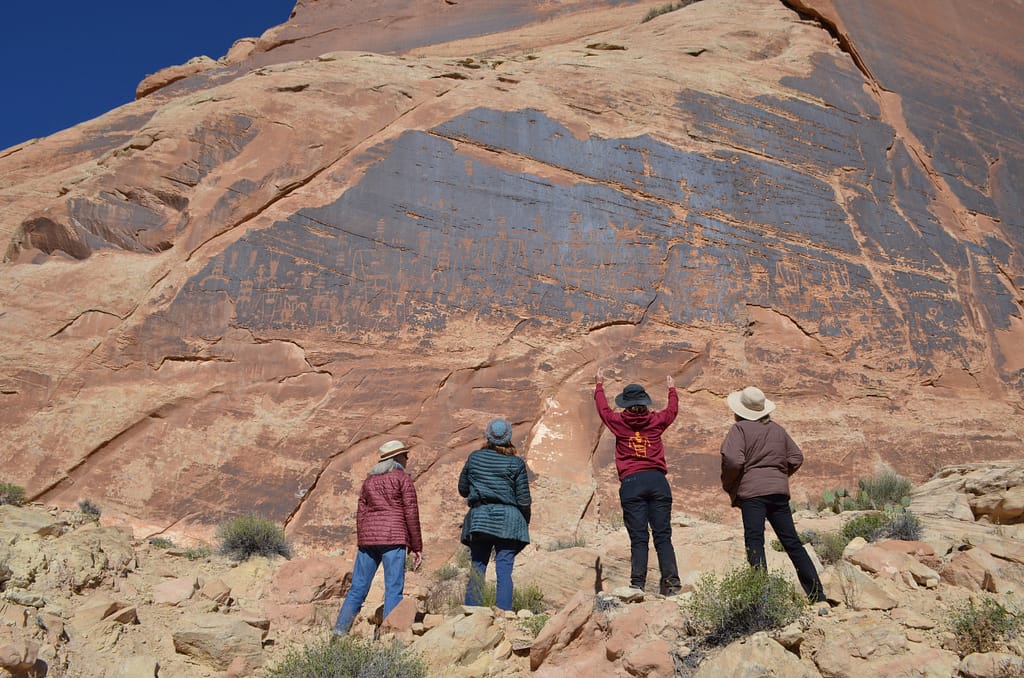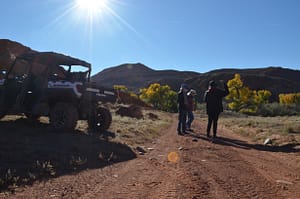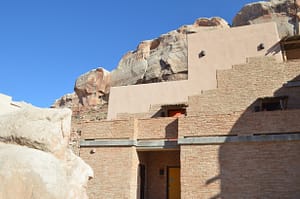Southeastern Utah and Bears Ears in Winter
- Bluff Dwellings Resort
- December 23, 2022
- Things To Do
Southeastern Utah is a land of solitude and wilderness. South of Moab—way south of Moab—the region’s distinctive Cedar Mesa sandstone folds, faults, and erodes into the monoclines, anticlines, canyons, and natural bridges of the expansive Bears Ears National Monument region. It is a vast and minimally populated landscape. It is, in a word, remote. Especially in winter.
“There’s still a place where you can find real peace and beauty and feel like you are the only one discovering it within hundreds of miles. The wintertime just amps it up a few notches. You might not see another car all day, even out on Highway 95 in the heart of Bears Ears,” says Jared Berrett, co-founder (with his wife, Spring) of Bluff Dwellings Spa and Resort.
Not sure where to start? A base camp at Bluff Dwellings combined with the expert guides of Wild Expeditions can help you access the solitude and wilderness.
Where to Stay Near Bears Ears
In southeastern Utah, the towns are smaller, which can lead to limited services. That means a couple of things for visitors to this part of southern Utah in winter: be fully self-sufficient or do your research to understand what is open. Either way, keep in mind that the Bears Ears region is still extraordinarily undeveloped no matter the season—and that’s a good thing.
Bluff Dwellings Spa and Resort in Bluff, Utah, is open for the first time for the 2022–23 winter season. That includes the Cedar Shake Cafe, the HozHo Spa, outdoor fire pits, and 104-degree hot tub, perfect for relaxing any time of day or under the evening stars. We also keep the pool open for that “polar plunge,” if you’re so inclined.
For some, these amenities, the luxurious Ancient Pueblo-inspired rooms, and the views of the 200-foot sandstone cliffs behind the Dwellings can make for a complete winter retreat. For others, there are land-based adventures through Wild Expeditions such as winter hiking and side-by-side RZR tours on Bears Ears National Monument. If you’re in the second group, here’s what you need to know.
Things to Do Bears Ears National Monument in Winter
While fewer daylight hours and more extreme weather conditions can limit some adventure, the team at Wild Expeditions continue to run many of our most popular guided experiences: intimate guided hikes or Utility Task Vehicle (UTV) excursions to ancient cliff dwellings, stunning canyons, and astonishing panels of petroglyphs and pictographs telling stories both known and unknown from the land’s human past. We offer half-day and full-day tour options catered to your level of adventure and interest. Here are a few highlights:
Introduction to Bears Ears: If this is your first time, have limited mobility, or simply aren’t certain about the idea of winter adventure, this easy sightseeing tour is an excellent start. We’ll give you just a taste of the vast geography and still send you home with incredible memories and newfound appreciation for this place.
River House: Accessible only via a day trip on the San Juan River or a very fun, but very rough, 4×4 backcountry route, this stunning two-story Ancestral Puebloan dwelling is a must-see of Bears Ears National Monument. Our professional guides will do the work of navigating the UTV and steer you along the dramatic Comb Ridge to the site and make a stop at the Big Kachina Panel.
House on Fire: Perhaps the most well-known site in Bears Ears, House on Fire is a relatively flat 3-mile, round-trip hike. Going with a Wild Expeditions guide will add extensive knowledge and storytelling about the region and likely convince you of the need to return to Bears Ears in the future to experience more.
The Citadel: This could be the signature hike of Cedar Mesa and Bears Ears National Monument. After a scenic drive to the western side of the mesa and a 4×4 jostle to the trailhead, this 5-mile, round-trip hike with some rocky scrambles crosses a narrow land bridge then ascends a knob of sandstone to an astonishingly well-preserved dwelling with “defensive” views for miles. You will talk about this one for years.
While Bears Ears is one of the primary destinations, visitors to southeastern Utah can easily fill an itinerary of three or more days with trips to Hovenweep National Monument, Goosenecks State Park, Monument Valley Navajo Tribal Park and other destinations within the boundaries of Bear Ears, such as National Bridges National Monument and Valley of the Gods.
Meanwhile, Bluff Fort tells the story of the land’s Mormon pioneer history while Edge of the Cedars State Park Museum in nearby Blanding reveals the rich archaeological past to help visitors to Bears Ears fully appreciate the land’s human history and why it is important to Respect and Protect that heritage. Wild Expedition’s own motto is Enjoy, Educate, Preserve, and Protect.
How to Plan and Prepare
Go with a guide: Our top tip for those who are new to the area, inexperienced with winter outdoor recreation, or simply want to see and learn more, is to go with a Wild Expeditions guide. They’ll have all the intel on where to go and current conditions, necessary permits, and safety tools, including satellite communications. And you will have fewer details to worry about (see “What to Pack” next section) and will benefit from expert local knowledge and storytelling.
Monitor conditions: Weather can change rapidly. When going with a guide, they will make informed decisions about when and whether to change an itinerary due to changing conditions. This also applies to driving, including avoiding unpaved backcountry roads or the switchbacks of the Moki Dugway (closures can occur), and navigating paved highways if you are inexperienced or your tires lack tread or traction. For those exploring with a guide, extra provisions and fuel in your vehicle may also be helpful.
Watch the time and take your time: In winter, nightfall can sneak up on you and with it come dramatically colder temperatures. Comfortable daytime temps in the 50s can slip to below freezing. Don’t try to pack too much into your day. If hiking, move at a comfortable pace especially if slickrock is wet and remember to drink plenty of water even if you don’t feel thirsty, knowing that you’ll be between 4,500 and 7,500 feet above sea level.
What to Pack
Perhaps one word summarizes what to pack for a winter visit to the Bears Ears region: layers. That’s because the temperature varies dramatically over the course of the day and night on the high desert plateau. Combine that with the type of activity you’re doing and it’s simply best to be prepared. “It’s the same great place with different clothes on,” as Berrett puts it. But it will make a difference whether you’re riding in a UTV with the wind wiping across your face or hiking in a sunny canyon. You might start the day with multiple layers but start carrying some of them in your pack by the afternoon.
Layers: It’s similar to how you’d layer up for skiing or other winter sports minus the heavy ski pants and mittens. For those without that kind of experience, here’s what we mean:
- A base layer, sometimes synthetic, sometimes natural wool, these porous layers wick away moisture yet dry quickly. A lower-body base layer can also be helpful, especially paired with mobile, stretchy-fabric hiking pants. Avoid cotton.
- A mid-layer like a fleece sweater or coat insulates to maintain body heat.
- An outer layer or shell like a “puffy” jacket of down or synthetic filling can offer weather protection and breathability depending on the construction. They can also be stuffed into a daypack if you get warm and quickly warm you back up if conditions change when you’re out of sun exposure or later in the afternoon as it starts to cool off again.
- Talk with your guides about the itinerary and weather if you are unsure.
Other essentials:
- A daypack for carrying all these things and layer management.
- Stocking cap, beanie, or even a headband for keeping your head and ears warm.
- Gloves, though usually not heavy ski/snowboard mittens.
- Solid hiking boots with good soles to help on slickrock.
- In some conditions or on certain trails, trekking poles or spiky traction cleats such as Yaktrax may be helpful. (Consult with your guide).
- A hydration bladder/reservoir or water bottles matched with the amount of hiking.
- Protein-rich, calorie-dense snacks. (Wild Expeditions guides will carry snacks or lunches for longer excursions.)
It sounds like a lot, and it certainly can be. But the reward for careful planning or traveling with a guide means safe access to all that wilderness and solitude this land offers. For some, that will be deep reflection and introspection on quiet exploration. For others, it is family adventure and the ability to connect with each other in nature. No matter how you experience the Bears Ears region of southeastern Utah this winter, expect to come away with a deeper appreciation for our shared land’s human history and the knowledge that wild places still exist.




